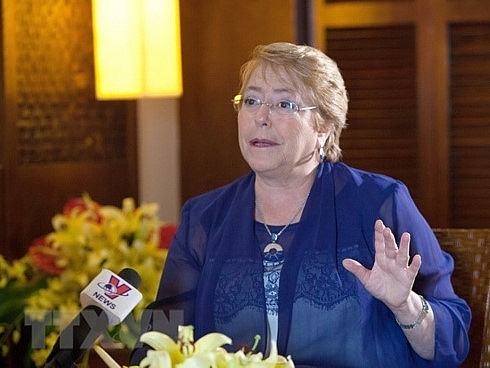Chile ready for CPTPP signing ceremony
 |
| Chilean President Michelle Bachelet |
Trade ministers of other countries negotiating the trade pact, namely Australia, Brunei, Canada, Malaysia, Mexico, Japan, New Zealand, Peru, Singapore and Vietnam, will attend the event.
CPTPP was launched a year ago after the US withdrew from the Trans-Pacific Partnership (TPP) agreement. It sets high criteria in numerous fields, including labour, the environment, intellectual property, digital economy and cyber security.
Twenty-two provisions of the CPTPP, including sensitive ones related to intellectual property, were suspended or changed in comparison to the TPP.
The pact is expected to facilitate for the promotion of economic growth and job generation, poverty reduction, and improvement of people’s living conditions.
It will be a strong message against protectionism, while proving that an opening economy will benefit member nations, according to experts.
The pact, once signed, will create one of the world’s largest free trade blocs with a combined market of 463 million people and GDP of around $10 trillion, accounting for 13 per cent of the global GDP.
It will bring about important commitments involved in non-tariff barriers, services, investment and other fields.
The pact will come into force 60 days after it is fully ratified by six of the 11 members.
What the stars mean:
★ Poor ★ ★ Promising ★★★ Good ★★★★ Very good ★★★★★ Exceptional
Themes: CPTPP
Related Contents
Latest News
More News
- Long-term capital seen as key hurdle to green growth (December 16, 2025 | 08:00)
- HDS Summit spotlights Vietnam’s rising role in regional supply chains (December 16, 2025 | 08:00)
- Agribank frames bank credit as catalyst for green growth (December 15, 2025 | 17:59)
- Legal framework completed for national digital transformation (December 13, 2025 | 21:55)
- SOAR initiative launched at TECHFEST Vietnam 2025 (December 13, 2025 | 10:00)
- Promoting digital assets initiative in Vietnam (December 13, 2025 | 09:30)
- Legislation gives government flexibility for loan guarantees (December 11, 2025 | 18:04)
- Vietnam masters core technologies of automobile value chain (December 11, 2025 | 17:46)
- Japanese investors pursue M&A strategies with long-term vision in Vietnam (December 11, 2025 | 12:14)
- Raising product quality to secure Vietnam’s position in US market (December 11, 2025 | 12:00)

 Tag:
Tag:

























 Mobile Version
Mobile Version